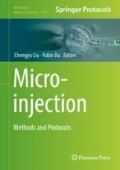Abstract
Exogenous genes can be site-specifically integrated into the genomic DNA of animals by homologous recombination, generating transgenic animals. These animals have a clear hereditary background, although position effects of the exogenous genes and potential functional disruption of host genes can be caused by the genetic inserts. Therefore, the generation of mammary gland bioreactors via gene-targeting methods is a great asset for producing recombinant proteins in milk. Here, we describe a method of generating gene-targeted goats with the human alpha-lactalbumin gene (hα-LA) integrated into the beta-lactoglobulin gene (BLG) locus. The milk from these goats will be less allergenic and will be enriched with components of human milk protein.
Access this chapter
Tax calculation will be finalised at checkout
Purchases are for personal use only
References
Capecchi MR (1989) Altering the genome by homologous recombination. Science 244(4910):1288–1292
Anastassiadis K, Schnutgen F, von Melchner H, Stewart AF (2013) Gene targeting and site-specific recombination in mouse ES cells. Methods Enzymol 533:133–155
Proudfoot C, Carlson DF, Huddart R, Long CR, Pryor JH, King TJ, Lillico SG, Mileham AJ, McLaren DG, Whitelaw CB, Fahrenkrug SC (2015) Genome edited sheep and cattle. Transgenic Res 24(1):147–153
Laible G, Alonso-Gonzalez L (2009) Gene targeting from laboratory to livestock: current status and emerging concepts. Biotechnol J 4(9):1278–1292
Wang X, Niu Y, Zhou J, Yu H, Kou Q, Lei A, Zhao X, Yan H, Cai B, Shen Q, Zhou S, Zhu H, Zhou G, Niu W, Hua J, Jiang Y, Huang X, Ma B, Chen Y (2016) Multiplex gene editing via CRISPR/Cas9 exhibits desirable muscle hypertrophy without detectable off-target effects in sheep. Sci Rep 6:32271
Samiec M, Skrzyszowska M (2011) Transgenic mammalian species, generated by somatic cell cloning, in biomedicine, biopharmaceutical industry and human nutrition/dietetics--recent achievements. Pol J Vet Sci 14(2):317–328
Murray JD, Maga EA (2016) Genetically engineered livestock for agriculture: a generation after the first transgenic animal research conference. Transgenic Res 25(3):321–327
Kuroiwa Y, Kasinathan P, Matsushita H, Sathiyaselan J, Sullivan EJ, Kakitani M, Tomizuka K, Ishida I, Robl JM (2004) Sequential targeting of the genes encoding immunoglobulin-mu and prion protein in cattle. Nat Genet 36(7):775–780
Richt JA, Kasinathan P, Hamir AN, Castilla J, Sathiyaseelan T, Vargas F, Sathiyaseelan J, Wu H, Matsushita H, Koster J, Kato S, Ishida I, Soto C, Robl JM, Kuroiwa Y (2007) Production of cattle lacking prion protein. Nat Biotechnol 25(1):132–138
Zhao LH, Zhao YH, Liang H, Yun T, Han XJ, Zhang ML, Zhou X, Hou DX, Li RF, Li XL (2015) A promoter trap vector for knocking out bovine myostatin gene with high targeting efficiency. Genet Mol Res 14(1):2750–2761
Takahagi Y, Fujimura T, Miyagawa S, Nagashima H, Shigehisa T, Shirakura R, Murakami H (2005) Production of alpha 1,3-galactosyltransferase gene knockout pigs expressing both human decay-accelerating factor and N-acetylglucosaminyltransferase III. Mol Reprod Dev 71(3):331–338
Rogers CS, Hao Y, Rokhlina T, Samuel M, Stoltz DA, Li Y, Petroff E, Vermeer DW, Kabel AC, Yan Z, Spate L, Wax D, Murphy CN, Rieke A, Whitworth K, Linville ML, Korte SW, Engelhardt JF, Welsh MJ, Prather RS (2008) Production of CFTR-null and CFTR-DeltaF508 heterozygous pigs by adeno-associated virus-mediated gene targeting and somatic cell nuclear transfer. J Clin Invest 118(4):1571–1577
Klymiuk N, Mundhenk L, Kraehe K, Wuensch A, Plog S, Emrich D, Langenmayer MC, Stehr M, Holzinger A, Kroner C, Richter A, Kessler B, Kurome M, Eddicks M, Nagashima H, Heinritzi K, Gruber AD, Wolf E (2012) Sequential targeting of CFTR by BAC vectors generates a novel pig model of cystic fibrosis. J Mol Med 90(5):597–608 Berl
McCreath KJ, Howcroft J, Campbell KH, Colman A, Schnieke AE, Kind AJ (2000) Production of gene-targeted sheep by nuclear transfer from cultured somatic cells. Nature 405(6790):1066–1069
Yu G, Chen J, Yu H, Liu S, Xu X, Sha H, Zhang X, Wu G, Xu S, Cheng G (2006) Functional disruption of the prion protein gene in cloned goats. J Gen Virol 87(Pt 4):1019–1027
Zhu C, Li B, Yu G, Chen J, Yu H, Xu X, Wu Y, Zhang A, Cheng G (2009) Production of Prnp −/− goats by gene targeting in adult fibroblasts. Transgenic Res 18(2):163–171
Luo Y, Wang Y, Liu J, Cui C, Wu Y, Lan H, Chen Q, Liu X, Quan F, Guo Z, Zhang Y (2016) Generation of TALE nickase-mediated gene-targeted cows expressing human serum albumin in mammary glands. Sci Rep 6:20657
Cheng Y, An LY, Yuan YG, Wang Y, Du FL, Yu BL, Zhang ZH, Huang YZ, Yang TJ (2012) Hybrid expression cassettes consisting of a milk protein promoter and a cytomegalovirus enhancer significantly increase mammary-specific expression of human lactoferrin in transgenic mice. Mol Reprod Dev 79(8):573–585
An LY, Yuan YG, Yu BL, Yang TJ, Cheng Y (2012) Generation of human lactoferrin transgenic cloned goats using donor cells with dual markers and a modified selection procedure. Theriogenology 78(6):1303–1311
Zou X, Wang Y, Cheng Y, Yang Y, Ju H, Tang H, Shen Y, Mu Z, Xu S, Du M (2002) Generation of cloned goats (Capra hircus) from transfected foetal fibroblast cells, the effect of donor cell cycle. Mol Reprod Dev 61(2):164–172
Author information
Authors and Affiliations
Corresponding author
Editor information
Editors and Affiliations
Rights and permissions
Copyright information
© 2019 Springer Science+Business Media, LLC, part of Springer Nature
About this protocol
Cite this protocol
An, L., Yang, L., Huang, Y., Cheng, Y., Du, F. (2019). Generating Goat Mammary Gland Bioreactors for Producing Recombinant Proteins by Gene Targeting. In: Liu, C., Du, Y. (eds) Microinjection. Methods in Molecular Biology, vol 1874. Humana Press, New York, NY. https://doi.org/10.1007/978-1-4939-8831-0_23
Download citation
DOI: https://doi.org/10.1007/978-1-4939-8831-0_23
Published:
Publisher Name: Humana Press, New York, NY
Print ISBN: 978-1-4939-8830-3
Online ISBN: 978-1-4939-8831-0
eBook Packages: Springer Protocols

